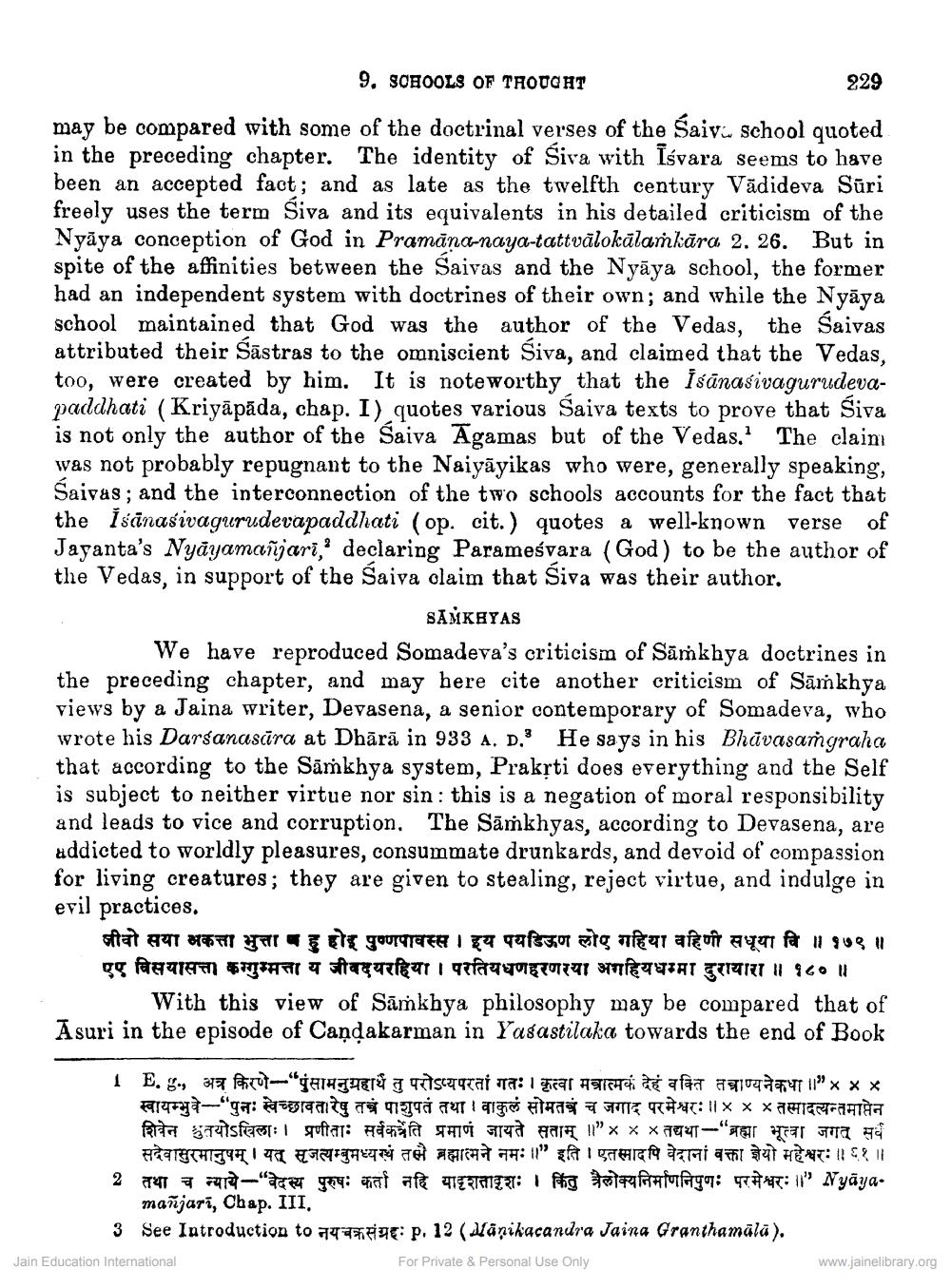________________
9. SOHOOLS OF THOUGHT
229
may be compared with some of the doctrinal verses of the Saivu school quoted in the preceding chapter. The identity of Siva with īśvara seems to have been an accepted fact; and as late as the twelfth century Vādideva Sūri freely uses the term Siva and its equivalents in his detailed criticism of the Nyāya conception of God in Pramāna-naya-tattvälokālaṁkāra 2. 26. But in spite of the affinities between the Saivas and the Nyāya school, the former
an independent system with doctrines of their own; and while the Nyāya school maintained that God was the author of the Vedas, the Saivas attributed their Šāstras to the omniscient Siva, and claimed that the Vedas, too, were created by him. It is noteworthy that the iśānasivagurudevapaddhati (Kriyāpāda, chap. I) quotes various Saiva texts to prove that Siva is not only the author of the Saiva Agamas but of the Vedas. The claim was not probably repugnant to the Naiyāyikas who were, generally speaking, Saivas; and the interconnection of the two schools accounts for the fact that the išānasivagurudevapaddhati (op. cit.) quotes a well-known verse of Jayanta's Nyāyamañjari,' declaring Parameśvara (God) to be the author of the Vedas, in support of the Saiva claim that Siva was their author.
SĀÅKBYAS We have reproduced Somadeva's criticism of Sāmkhya doctrines in the preceding chapter, and may here cite another criticism of Sāṁkhya views by a Jaina writer, Devasena, a senior contemporary of Somadeva, who wrote his Darsanasura at Dhārā in 933 A. D.' He says in his Bhāvasañgraha that according to the Sāṁkhya system, Prakrti does everything and the Self is subject to neither virtue nor sin : this is a negation of moral responsibility and leads to vice and corruption. The Sāṁkhyas, according to Devasena, are addicted to worldly pleasures, consummate drunkards, and devoid of compassion for living creatures; they are given to stealing, reject virtue, and indulge in evil practices.
जीवो सया भकत्ता भुत्ता बहु होइ पुण्णपावस्स । इय पयडिऊण लोए गहिया वहिणी सधूया वि ॥ ७९ ॥ एए विसयासत्ता कग्गुम्मत्ता य जीवदयरहिया । परतियधणहरणरया अगहियधम्मा दुरायारा ॥ १८ ॥
With this view of Sāmkhya philosophy may be compared that of Asuri in the episode of Caņdakarman in Yasastilaka towards the end of Book
1 E.S., 37 PTU- JA TË I segrai ta: car fi afar 14 YT 11" X X X
स्वायम्भुवे-"पुनः खच्छावतारेषु तत्रं पाशुपतं तथा । वाकुलं सोमतत्रं च जगाद परमेश्वरः॥xx x तस्मादत्यन्तमाप्तेन शिवेन श्रुतयोऽखिलाः। प्रणीताः सर्वकडेति प्रमाणं जायते सताम् ॥" x x x तद्यथा-"ब्रह्मा भूत्वा जगत् सर्व
सदेवासुरमानुषम् । यत् सृजत्यम्बुमध्यस्थं तले ब्रह्मात्मने नमः" इति । एतस्मादपि वेदानां वक्ता ज्ञेयो महेश्वरः ॥६१॥ 2 747 3 ard-ach you al afet ATERIATE: Ifa ag for forfarge: Y TT: 1/" Nyāya.
mañjari, Chap. III,
3 See Introduction to 7495 : p. 12 Månikacandra Jaina Granthamālā). Jain Education International For Private & Personal Use Only
www.jainelibrary.org




